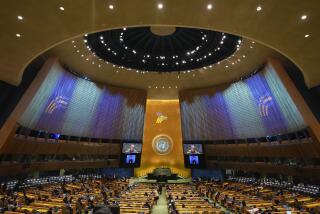Keeping the Nuclear Genie in the Bottle : While not perfect, the nuclear non-proliferation pact has worked well
By any reasonable measure the quarter-century-old nuclear Non-Proliferation Treaty has been a historic achievement, clearly the most inclusive and effective international arms control effort ever undertaken.
The NPT has been the primary legal instrument for keeping the five declared nuclear-weapons states--the United States, Britain, China, France and Russia--from transferring any nuclear explosive devices or technology to any other state. With a few exceptions its additional priority of barring non-nuclear-weapons states from seeking nuclear arms has also been met. Where deception and cheating have been carried out--notably by Iraq and North Korea--the pact’s enforcement machinery has helped make exposure possible, forced verifying inspections and opened the way for U.N. actions leading to sanctions.
Without the NPT it’s almost certain that an uneasy world would today be faced with a far larger number of nuclear states. The NPT has been an agreement that can honestly be said to have changed the course of history. Its success argues powerfully for its indefinite extension.
Achieving that extension is the chief goal of the United States during the current NPT conference in New York, being attended by the 178 signers of the treaty. In this it is backed by Britain, France and Russia. But China, the fifth declared nuclear power, which joined the NPT only in 1992, has sent uncertain signals about its policy. China now suggests that while it wouldn’t necessarily oppose indefinitely extending the pact neither would it object simply to renewable 25-year extensions. What’s the distinction? By approving the finite term option, China places itself on the side of various nonaligned states, led by Indonesia, Iran and Mexico, that want to allow for possible termination of the treaty. Why? By keeping open the possibility that the treaty would eventually expire and so remove a key barrier to other countries acquiring nuclear weapons, they seek to pressure the declared nuclear powers to further reduce their arsenals.
In fact a lot of the reduction has already occurred. “Good faith” negotiations to halt the nuclear arms race and achieve nuclear disarmament are required by the treaty, and dramatic progress has been made in at least the first of these requirements. When the NPT went into force in 1970 the United States deployed about 5,000 strategic warheads, the Soviet Union about 2,000. By the late 1980s, despite almost continuous arms control talks, the deployed U.S. strategic arsenal had swollen to about 13,000 warheads, the Soviet Union’s to about 11,000. The START I and START II treaties, achieved with the end of the Cold War, drastically reduced those arsenals. Under these agreements both countries will have no more than 3,500 deployed strategic warheads by the year 2003. That would be a 70% cut-- 17,000 warheads--from Cold War peaks. Simultaneously, of course, the missiles and bombers to deliver these weapons are being slashed.
The NPT is not, of course, an impregnable barrier to proliferation. India, Israel and Pakistan, all presumptive nuclear powers, remain non-signatories and so are not required to open their nuclear facilities to international inspection. North Korea and Iraq, as noted, have tried to evade the pact’s requirements. Washington is convinced that Iran has as well; the CIA has warned that Iran could produce a bomb within a decade. That concern has prompted sharp exchanges between the United States and Russia and China, both of which are ready to sell Iran certain nuclear equipment. Washington’s worry is that such peaceful technology could be diverted to more sinister purposes.
Absolute non-proliferation may be unachievable. The NPT nonetheless has kept a lid on the proliferation threat; in the end, it remains far easier to monitor and sanction a few worrisome nuclear-ambitious countries than a dozen or more. The NPT, bringing the vast majority of the world’s states under its rules, has been a laudable, even indispensable force for worldwide stability.
More to Read
Sign up for Essential California
The most important California stories and recommendations in your inbox every morning.
You may occasionally receive promotional content from the Los Angeles Times.










